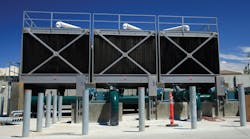In today’s fast-paced electrical construction industry, it’s not often a project is completed six months ahead of schedule and with no lost time incidents. At the Naval Hospital at Marine Corps Base Camp Pendleton, however, the construction team accomplished this feat by making safety an integral part of the job-site culture while working more than 2.5 million labor hours.
“I think it’s a great example of what can be accomplished when all the stakeholders work together,” says Carlos Gonzalez, project director for Clark McCarthy, a Joint Venture (CMJV). “The six-month advance completion is the result of everyone going above and beyond. The subcontractors performed at the highest level and delivered on their promises, so the great majority of work was right the first time.”
From the beginning, the Navy awarded the project earlier than initially anticipated, CMJV developed a plan supporting early completion, and the team experienced minimal delays resulting in rework. By starting construction as early as possible, the Navy was able to open the new hospital in early December, exactly three years from the initial groundbreaking on the 70-acre site. The new facility will serve as a replacement for a 39-year-old existing facility, which will be repurposed into administrative space.
Working as a team
The construction team built the 500,000-sq-ft, multi-level hospital near the front entrance of Marine Corps Base Camp Pendleton to make it easily accessible to the local community. While the former hospital emphasized in-patient care, the new facility reflects the current trend toward more outpatient services.
Naval Facilities Engineering Command Southwest (NAVFAC) and CMJV worked with a project team with both health-care construction experience as well as technical expertise with hospital equipment. The team included Bergelectric, the prime electrical contractor; MCB, the low-voltage contractor; GNC, the electrical equipment and material supplier; and HDR, HKS, and EXP, the project designers. The electrical contract ranked as the second largest specialty contract awarded on the job, with the lighting, electrical, and low-voltage work totaling $50 million, Gonzalez says.
“Bergelectric carried the biggest load on the project,” says Gonzalez. “An electrical contract is integral to a complex facility like a hospital because a lot of the equipment is driven by electricity, and technology relies on the connectivity of local and outside networks.”
Boosting productivity
Like any large-scale construction site, some of the most significant challenges were the oversight, planning, coordination, and logistics of managing such a large workforce, says Commander Dude Underwood, resident officer in charge of construction at Naval Hospital Camp Pendleton.
“At the peak of construction, we enjoyed having more than 1,000 trade workers on the site, and quality assurance and safety oversight for that scale of an effort was a challenge,” he says.
Because the project was design-build, construction began before the design team completed the drawings for the later phases of the project. Although about 60% of the Navy’s construction projects are design-build, it’s rare for the Navy to employ this method on health-care projects, Underwood says. By using this approach on the Camp Pendleton hospital, however, the team was able to stay ahead of schedule.
The project team also harvested time savings through building information modeling (BIM) and short interval production (SIP) scheduling. The design and construction team built a 3D model of the facility before the trades began their work in the field. This allowed for conflict resolution and minimized the problem of using the same space for multiple utilities.
With 2,000 rooms in the hospital, the SIP method helped the different trades coordinate their work schedules.
“We divided the building into areas and then flowed all of the different trades through these areas,” Underwood says. “It allowed us to stay on schedule and support the overall flow of the job.”
The SIP methodology was also used toward the end of the job to help with the punchlists. After construction was complete, Clark McCarthy installed the medical equipment and technology systems throughout the hospital.
Going for the gold
During construction of the hospital, the team not only saved time through BIM and SIP work methods, but also boosted energy efficiency through sustainable design and a focus on renewable energy.
While the Navy required Clark McCarthy to meet the standards for LEED silver certification, the company and its subcontractors went a step further by pursuing LEED gold. As a result, the hospital will have lower maintenance and operation costs in the future, according to Gonzalez.
“The cost of a building over its life span goes beyond just the cost of construction,” he says. “We tried to deliver better value over the long term through energy efficiency measures and by maximizing the efficiency of our equipment.”
To improve energy efficiency, the electricians installed LED and fluorescent lighting as well as equipment that was 30% more efficient than standard. For example, electricians installed energy-efficient boilers, chillers, cooling towers, and an emergency backup power system at the central utility plant.
“Our central utility plant is built with a great bit of resiliency and room for expansion,” says Underwood.
The electricians also installed a photovoltaic system on the roofs of two different parking structures. The solar thermal array captures the heat of the sun and then preheats some of the utilities in the central utility plant, further boosting efficiency, says Underwood.
Throughout the project, the team focused on creating not only an energy-efficient facility, but also a healing environment. The hospital includes such features as daylighting, a green roof, and outdoor healing gardens.
“One reason why we drove sustainability to a higher standard is the health of the patients in the hospital,” adds Gonzalez. “There is a principle in health-care design called evidence-based design, which states that if the environment is conducive to health and happiness, patients will heal faster.”
Safety first
In addition to focusing on energy efficiency, the team also concentrated on safety. From the start of the project, contractors conveyed the message that safety was paramount.
“We saw safety as one of the most important success measures that we were going to gauge ourselves by,” says Gonzalez. “We set out from the beginning to do the entire project with zero lost time incidents. It was unconventional, but we wanted to set the bar high.”
To accomplish this goal, the contractors, CMJV and NAVFAC implemented a leading indicator safety program called “Stop, Talk, and Accept.” When workers identified other employees performing an unsafe act, they would stop them and talk about the problem. The workers would then be responsible for accepting it, and changing out their behavior. Every time this happened, the workers would fill out a small card, which would be shared with the contractor. The firm would then use these cards to track where additional emphasis was needed to be placed to ensure the safety of the workforce.
By using this program as well as other safety measures, the contractors were able to keep the entire workforce safe in the field throughout the course of the three-year project. Through labor-saving methods, they also were able to finish the job not only on time but also ahead of schedule. As a result, active duty and retired military and their families can take advantage of the latest health care technology in a new, energy-efficient hospital without leaving Marine Corps Base Camp Pendleton.
Fischbach is a freelance writer based in Overland Park, Kan. She can be reached at [email protected].
For more images and additional project details, browse the exclusive photo gallery.





